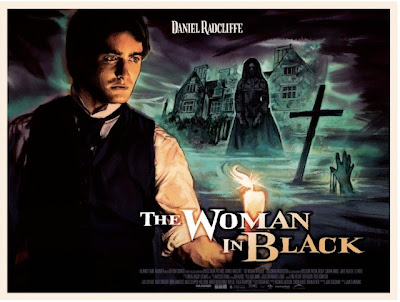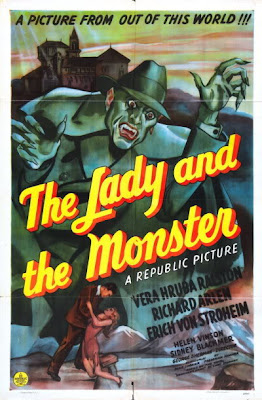Nine Horror Titles that Have Many Film Adaptations but Remain Sequel-Less
Posted by Admin at 5:12 PMThe Woman in Black, a ghost story that takes place during the Victorian era in England, made its debut in theaters across the US this weekend. While it's the first horror film from Hammer Films in decades, it's hardly a new tale. The Woman in Black started as a 1983 novel by Susan Hill, and it was later adapted for the theater, radio, and television.
With that in mind, I've assembled a list of nine horror stories that have three or more film adaptations under their belts. What these stories all have in common is that they started out on the printed page, either as books, novellas or play scripts. Yet unlike Dracula or Frankenstein--two of the most adapted horror novels in film history--none of the stories on this list ever got around to spawning a single film sequel or spinoff.
Click below to see these nine terror tales, which I've arranged according to the number of film adaptations that have been made for each title. Please note that some totals are estimated, because the more popular titles have been adapted so many times with varying degrees of faithfulness to the source material that it's difficult to determine which adaptations qualify as such. For example, the unpublished short story entitled "The Wax Works" by Charles Spencer Belden was adapted twice, once in 1933 and then in 3D in 1953. A third film in 2005 bears the same title as the 1953 version, House of Wax, but it is not based on the same source. Read on....
1. Conjure Wife by Fritz Leiber
Number of Movie Adaptations: 3, Weird Woman (1944), Night of the Eagle (a.k.a. Burn, Witch, Burn!) (1962), and Witches' Brew (a.k.a. Which Witch is Which?) (1980)
Skeptics hold a special place in the horror genre. By the end of the novel, TV show or movie, the skeptic usually becomes either a true believer or monster chow (or both)--no exceptions. Leiber took that character type one step further with his Conjure Wife novel, where the skeptic in the story discovers not only that his wife is using witchcraft to advance his career, but that the wife of one of his professional rivals is out to sabotage his career by the same means. No other skeptic in horror ever had it so bad, so much so that this novel has been adapted for the movies three times. Trivia bonus: The second adaptation was co-scripted by horror legend Richard Matheson.
2. Donovan's Brain by Curt Siodmak
Number of Movie Adaptations: 3, The Lady and the Monster (1944), Donovan's Brain (1953), and The Brain (1962)
A human brain kept alive in a jar is one of the many go-to concepts that writers use as shorthand for science run amok, and it can serve as either a main plot point in story or simply a background decoration in a mad scientist’s lab. Donovan’s Brain was the first story to popularize this idea among horror and sci-fi filmmakers, and it has three film adaptations to its name to prove it. Of course, this doesn’t begin to cover the countless Donovan’s Brain rip-offs that have been released since the first adaptation of Siodmak’s novel, rip-offs such as The Brain from Planet Arous, The Brain That Wouldn't Die, and They Saved Hitler’s Brain.
3. I Am Legend by Richard Matheson
Number of Movie Adaptations: 3, The Last Man on Earth (1964), The Omega Man (1971), and I Am Legend (2007)
It’s easy to lose count of the number of films and TV shows that have been adapted from Richard Matheson’s novels and/or from screenplays he’s written, but I Am Legend is the one that has been adapted the most times. What’s particularly noteworthy about this trilogy of adaptations are the diversity of actors who have starred as the main character (Vincent Price, Charlton Heston and Will Smith), none of the adaptations have the same ending as the novel, and that I Am Legend served as an inspiration of one of the most imitated horror films of all time: George Romero’s Night of the Living Dead.
4. The Island of Dr. Moreau by H.G. Welles
Number of Movie Adaptations: 3, Island of Lost Souls (1933), The Island of Dr. Moreau (1977), The Island of Dr. Moreau (1996)
Like Richard Matheson, H.G. Welles has provided plenty of material for movies; in Welles’ case, movie adaptations of his work date as far back as the silent era. While The Invisible Man and War of the Worlds may be two of his most well-known novels due to the popularity of their film adaptations and sequels, The Island of Dr. Moreau remains one of Welles’ most adapted works that has yet to produce a single sequel--plenty of rip-offs, but not a sequel.
5. The Body Snatchers by Jack Finney
Number of Movie Adaptations: 4
If the 1950s are to be a guide about understanding alien invasions to Earth, then we can expect the invaders to attack in one of two ways: They’ll either vaporize us with their high-tech weaponry as they did in War of the Worlds, or they’ll overrun us with human duplicates as in Invasion of the Body Snatchers. Jack Finney struck a significant chord in the collective human psyche when he envisioned an invasive alien race that did not need any form of advanced weaponry to conquer the human race; instead, they rapidly reproduced like hyper-fertile plants and effortlessly assumed the identities of people while they slept. Such a terrifying idea resulted in four adaptations and countless imitators, but not a single continuation of the original story.
6. The Cat and the Canary by John Willard
Number of Movie Adaptations: 6
The Cat and the Canary is the only title on this list that started as a stage play, which premiered in 1922. It’s also one of the few listed here that has been adapted either as a horror story or as a dark comedy. Nevertheless, its central plot--a group of people who come to a gloomy, secluded mansion for the reading of a will and find themselves stalked by a mysterious killer--was quite influential and has a inspired other titles in the horror genre, particularly in the giallo/slasher subgenre. It should also be noted that a similar play from the same era called The Bat was adapted for film three times, and that The Bat is credited by comic book writer Bob Kane as the inspiration for his most popular character, Batman.
7. Strange Case of Dr. Jekyll and Mr. Hyde by Robert Louis Stevenson
Number of Movie Adaptations: 10+
Horror and sci-fi characters who develop split personalities through mad science all have a common ancestor in Robert Louis Stevenson’s notorious Dr. Jekyll. Stevenson’s novella has been adapted so many times that it’s hard to get an exact count of what can be considered an actual adaptation. Further muddling the exact total are adaptations of this tale that add an element of gender bending, as was the case in Hammer’s Dr. Jekyll and Sister Hyde.
8. The Phantom of the Opera by Gaston Leroux
Number of Movie Adaptations: 10+
Gaston Leroux wrote many detective novels throughout his career, but his most popular story involves a vengeful, disfigured maniac who lurks behind the scenes at an opera house. Like Dr. Jekyll and Mr. Hyde, The Phantom of the Opera has been adapted so many times and in so many formats (it was adapted into a musical twice) that the exact total of adaptations remains unclear. It has also been adapted to fit more contemporary settings, as in the case of Phantom of the Paradise and Phantom of the Mall.
9. The Picture of Dorian Gray by Oscar Wilde
Number of Movie Adaptations: 10+
Curiously, the only published novel by Oscar Wilde also became one of the most adapted stories in horror cinema. Even though The Picture of Dorian Gray is a variation of sorts on the themes explored in Stevenson's Strange Case of Dr. Jekyll and Mr. Hyde (which was published four years prior to Dorian Gray), Wilde’s book takes the old adage of how beauty is only skin deep to such sinister depths that filmmakers found it too irresistible to avoid adaptation.
Subscribe to:
Post Comments (Atom)










0 comments:
Post a Comment